
The very quiet drama Lamb is one of the most gripping films of the year, and one of the most unsettling. I’ve seen Lamb described as a horror film, but it is very unlike most of today’s horror films. I would rather label it as a dark, cautionary fable of karma with some supernatural elements.
It’s difficult to imagine a more pastoral setting than Lamb’s remote Icelandic sheep farm. Maria (Noomi Rapace) and Ingvar (Hilmir Snær Guðnason) run the farm with studied competence, caring for the sheep and maintaining their tractor. No neighbors are in sight. Neither the routine nor the isolation burdens them; they are comfortable with and enjoy each other’s company.
One of their routine tasks is birthing lambs. We see that Maria and Ingvar have an established division of labor and confidence. We think we know what to expect until a lamb is birthed and Maria and Ingvar’s reaction shows that this newborn is anything but normal.
It’s remarkable that the two never debate what to do or consult experts. They both immediately fall into behaving in complete alignment. But we suspect that they are not behaving as most people would.
Writer-director Valdimar Jóhannsson is such an able story-teller, that he doesn’t show us the lamb’s body right away, and we have to surmise what’s going on by the reactions of the characters. When Ingvar’s nogoodnik bother Petur (Björn Hlynur Haraldsson) shows up uninvited, he brings with fresh eyes and asks WTF?
Jóhannsson uses the starkly beautiful but menacing Icelandic landscape to fill us with foreboding. Something is not right here. And there will come a reckoning.
Lamb drove me to the dictionary to review the meanings of the word monster. In Lamb, there is a creature who fits under the definition, but which is pure and sweet. Another creature is the terrifying kind of monster. And a human takes an action that is normal from a human point of view, but from a monster’s perspective is, well, monstrous.
The cast (and this is really a three-hander) is excellent. You may recognize Rapace as the pierced-and-inked Lisbeth Salander in the Swedish Girl with the Dragon Tattoo franchise.
Lamb is the first feature for Valdimar Jóhannsson – and it is a superb debut. You haven’t seen anything like this movie before.


